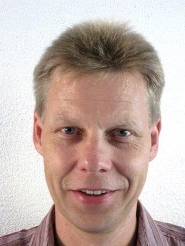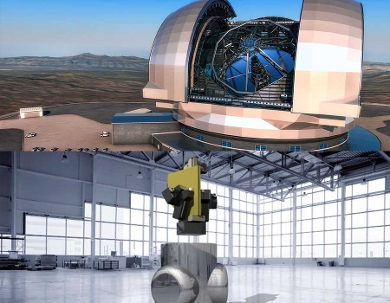
Gazing into deep space
Bernhard Brandl, the new Leiden Professor of Infrared Astronomy, is developing instruments for the world’s largest telescopes. These telescopes can be used to observe objects in space that are more than 13 billion years old. Brandl will deliver his inaugural lecture on 26 September.
Life’s biggest questions
Deep space – the part of the universe with the most distant galaxies – holds the answer to some of life’s biggest questions. How were stars and planets formed? Is there life on other planets? If astronomers want to look into deepest space, they need ever bigger telescopes, telescopes that can not only detect the most distant objects, but that can also ‘see’ these objects very clearly.

Heat around a young star
‘Seeing’ is not exactly what they do, because much of what happens in deep space is deduced from infrared images. As an example: when a star is born, this newcomer is surrounded by large amounts of gas and dust. The dust absorbs the heat of the young star, and this heat can be detected using infrared technology. Bernhard Brandl analyses infrared observations made using telescopes both on Earth and in space. He is also working on developing infrared instruments that will be incorporated into these telescopes. He conducts this research within his combined appointment as a professor in Leiden and at TU Delft.
One photon per year
The telescopes and cameras being constructed with Brandl’s help are enormously large and complex instruments. They need to be. Brandl: ‘The most distant galaxy in the universe that we can observe is around 10 billion times fainter than the faintest object we can see with the naked eye. This means that if you were to look with the naked eye at the most distant galaxy, your eye would receive one photon (light particle) per year from that galaxy. Telescopes are now being constructed that can receive two photons per second from that same galaxy.’

Biggest telescopes ever
Brandl is working on optical instruments for the world’s biggest telescope, which will be launched in space in 2018 – the James Webb Space Telescope (JWST) – and the biggest telescope on Earth – the European Extremely Large Telescope (E-ELT) that should be operational in 2024. These are the largest optical telescopes ever to be constructed by man. The instruments on which Brandl is working receive infrared light. Without these instruments, the telescopes would be ‘blind’. Brandl is Principal Investigator for METIS, the camera on the E-ELT. This camera is the biggest Dutch project ever in the field of groundbased infrared astronomy.
Construction of telescopes increasingly complex
Brandl is enthusiastic about the construction of these giant telescopes, but he also has a warning about the future: we cannot simply continue to build bigger and bigger telescopes. ‘It’s too expensive, and the technology and logistics are making designing and constructing such telescopes increasingly complex. The METIS project, the infrared instrument on the E-ELT, has already been going on for more than 20 years, since the initial phase. The bigger the projects, the longer they take. It won’t be long before it becomes impossible to complete a project within a single working lifetime.’
Opportunities in the consumer market
But Brandl sees other opportunities for tackling these problems. ‘Manufacturers for the consumer market are developing technologies that can also benefit astronomy. Small infrared detectors for driverless cars, for example. If the manufacturers manage to keep the cost and size of these components at reasonable levels, this could offer interesting leads for making the transition to instruments.’
The image above this article was made by the Hubble Space Telescope. It shows the most distant galaxies. It's a composite of the most colourful images made in a nine-year period (Source: NASA / Hubble Space Telescope).
Inaugural lecture
Bernhard Brandl will deliver his inaugural lecture (in English) on Monday 26 September in the Academy Building in Leiden. If you'd like to attend, please register here.
